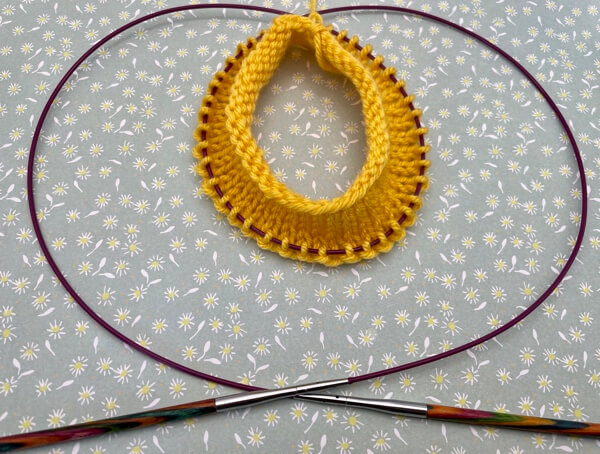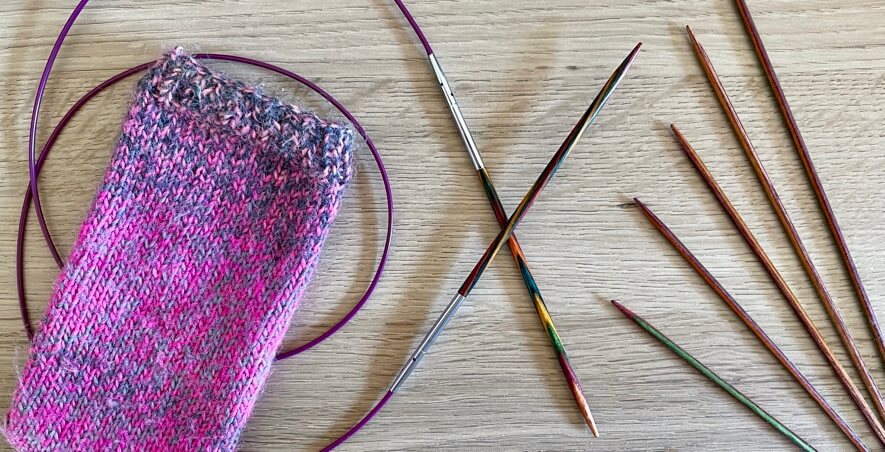How To Change From Circular To Double Pointed Needles
Craft Fix is reader-supported. If you cull to buy via certain links I could earn a pocket-size commission at no cost to yous more
Yes, circular needles are a great alternative to double pointed in many cases. In fact, many knitters prefer to use circular needles over DPNs for a number of reasons.
I learned to knit in the circular using double pointed needles myself & still use them for certain projects. Only I am a consummate convert to the magic loop technique using one long circular needle & at present utilize this instead of straight needles wherever possible.
Why are Circular Needles ameliorate than DPNS?
1. Easier to work with fewer Needles
The bandage on and first few rows with double pointed needles is awkward and messy. There are pointy tips everywhere. Yous experience like Edward Scissorhands!
If you utilise a circular needle instead, it's much easier to start your projection. Merely cast on the full amount of stitches onto your circular needle. If using a long round needle (magic loop technique), pull out a length of cablevision halfway to divide your stitches in 2 and away you get.
2. You can't lose your Needles!
It'due south incommunicable to lose a circular knitting needle during your projection, because your knitting hangs right in the middle of it. They are more bad-mannered to shop when not in use, but at to the lowest degree that means they won't go AWOL on yous!
With double point needles, there is always a spare needle not in use and herein lies the danger. DPNs usually come in sets of 5, but my favourite KnitPro symfonie wooden DPNs actually come in packs of 6 because they know every knitter will lose ane sooner or later. In North America, these are sold as Knitter's Pride dreamz needles but you only get a standard 5 pack. Peradventure US knitters know the secret to not losing DPNs. 😉
3. No risk of dropping Stitches
Your knitting stitches are always safety and sound on a circular needle cable, well abroad from the needle tips. But your stitches are dangerously close to the ends when you are using short double pointed needles, .
Even while knitting, a few stitches tin can drop off the end of a DPN without you knowing. Between knitting sessions, the adventure increases. Stitches can easily come off the end of these brusk straight needles just moving around in a project purse.
Yous tin get little betoken protectors for DPN tips to keep your stitches safe between knitting sessions. But it's fiddly hassle doing this and they don't always stay put either.
4. Easier to try on equally you go
If you are making a pair of socks or gloves, fit is vital. Information technology's best to try on regularly equally yous become but that's catchy with DPNs. With lots of short straight needle points it'southward all besides easy for stitches to drib off every bit yous try to get your hand or foot in. You lot could move your stitches on to a length of yarn first, but that's a load of faff.
If you use a long circular needle (magic loop arroyo), you can hands guess the size and shape at whatsoever time by merely pulling out both needle tips leaving all your stitches on the cablevision. This also makes it really easy to effort on your hand, foot or head at whatever time.
I recommend trying on from early on in your project, and then you lot can quickly start again if the fit is wrong.

five. Less likely to take Ladders betwixt Needles
When using DPNs, your knitting may wait a scrap different at the points where 2 needles meet. The modify in tension tin cause loose stitches which leaves a slight gap. Then you go visible lines or ladders down your knitting where each DPN ends. These can wash out but it's not a smashing wait.
If y'all struggle with laddering, using a round needle instead often solves this trouble.

When should you employ DPNs rather than Circular Needles?
Double pointed needles are still the best option in certain cases. It's easier to use DPNs instead of a circular needle when knitting very modest circumferences in the round.
For example, while you can easily knit the primary part of a glove on a circular, it's best to knit each glove finger on double pointed needles.
Double pointed needles also come in handy when knitting modest toy parts in the round. Knitting fiddly $.25 in the round is usually much easier on DPNs.

How to use one Long Circular Needle instead of DPNs (Magic Loop)
The easiest mode to knit small items similar socks, gloves, hats and toys without DPNs is to use one long circular needle. This knitting technique is called the magic loop. Information technology'south best to use a circular needle that is 100-150cm long for this. An 80cm long circular will also work for pocket-sized stitch counts, but it won't exist as comfortable to work with. I also find the halfway point column can be noticeable in my knitting if I use too curt a cable.
Here is a skilful magic loop video tutorial or you lot can follow the steps beneath:
How to cast on and knit using the Magic Loop method
Cast on all the stitches on your circular needle.
Motility all the stitches down the cable.
Split your stitches in one-half
Find the halfway betoken of your cast on stitches. Hold the 2 halves of your stitches in your dominant hand and pull out the cable at the halfway point with your other paw to split your stitches in half.
Slide stitches up to needle tips
Slide each half of stitches up to the points of your needle, with a big loop of cable left betwixt them.
Your working yarn should be hanging from the end of your back needle tip.
Get in position to first knitting
Holding the 2 needle tips together in your left hand (if right handed), pull the back tip out with your right paw and around to meet the front end needle. In that location should however be a good loop of cable out the left side simply plenty cablevision on the right so you lot tin comfortably knit into the first stitch on the front end needle.
Knit beyond the first one-half of your stitches and turn your work
Go in position to knit 2nd half
Button the front end needle downwardly so the forepart stitches are on it. Hold both needles together again and pull the back tip out and around again as before.
Knit across the 2nd half of your stitches to complete round i
Go on repeating steps 4-7 to complete each round
Knit half a circular and yank your cable each time. You should ever have a loop of cable hanging out of both sides as you work. This reminds me of Dumbo the elephant's ears!

The magic loop looks quite odd and feels strange at first as well, but it before long becomes second nature. In one case y'all larn magic loop, information technology's a existent game changer. Instead of needing lots of different length round needles, yous can employ ane long circular needle to knit socks, hats, sleeves & even parts of sweaters.
How to convert a Pattern written for DPNs to Circular Needles?
You can knit near patterns written for double pointed needles with a long round needle instead.
If information technology is a complex pattern, a handy tip is to identify a sew together marker at the bespeak where each DPN would end. Identify a marker at the 1/three and two/three points if your pattern uses only 4 DPNs. If your pattern uses 5 DPNs, which divides your stitches in 4, just place a marker halfway along each half of your magic loop instead.
Ignore the DPN cast on and segmentation instructions. Merely cast on all your stitches on to your circular needle. Then split them in two ready to knit using the magic loop technique (explained above).
So your stitches are merely divided in half rather than thirds or quarters every bit described in the DPNs pattern. Working in halves is usually more intuitive and makes it easier to judge size and shape too.
You can merely follow along your design, taking care wherever it mentions needle 1 to 3 (or iv) so that yous knit to the same point in your round. That's why placing iii-iv markers where each DPN would end can assist.
Tips for knitting Socks and Gloves with Magic Loop instead of DPNs
Sock patterns most usually use v DPNs, where your stitches are divided evenly among 4 needles. It's really uncomplicated to knit these patterns with a long circular needle instead. The stitches from needle 1 and 2 will but be the front half of your magic loop, with needles three and iv replaced by the back half.
If you lot are making gloves, I still recommend switching to double pointed needles near the stop of the design to knit the individual fingers and thumb. There are so few stitches involved here that they are much easier to make with DPNs.
I hope this post helps you understand when and how to use a circular needle instead of double pointed needles. I'm a big fan of magic loop knitting for small accessories, but DPNs are still part of my knitting toolkit. There is no right or incorrect here of course. Whether y'all're a die hard DPNs fan or swear past circulars, the main thing is to enjoy your knitting. 😊
How To Change From Circular To Double Pointed Needles,
Source: https://www.craftfix.com/circular-vs-double-pointed-needles/
Posted by: martinhignisfat.blogspot.com




0 Response to "How To Change From Circular To Double Pointed Needles"
Post a Comment